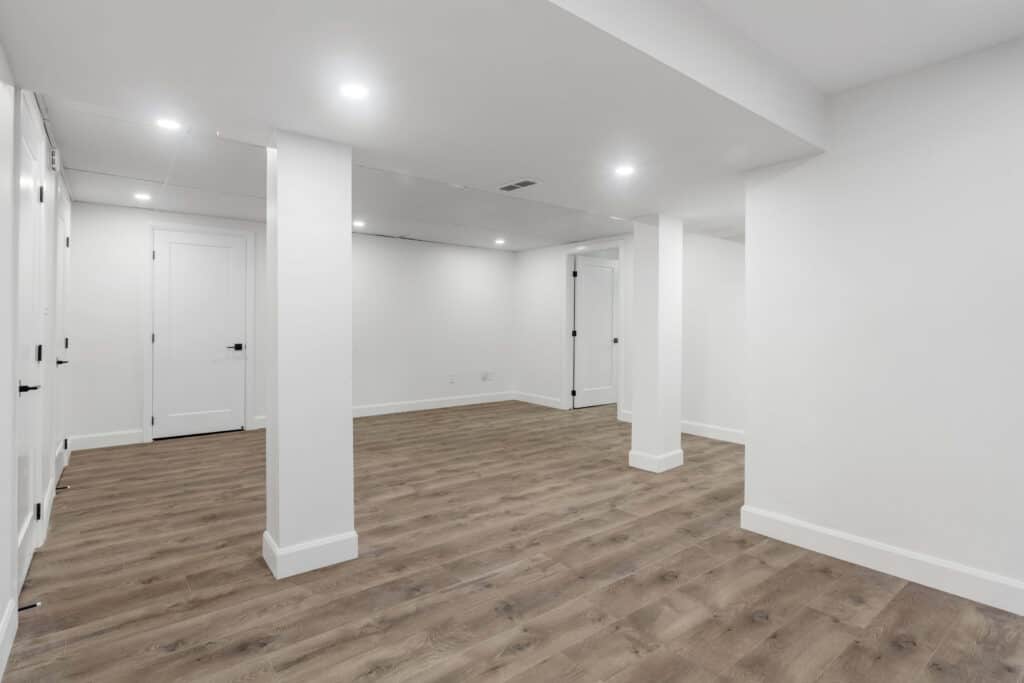
Putting up drywall in a basement may transform an unfinished area into a new bedroom, recreation room, or office. But is it necessary for you to apply for a permit, nevertheless, to carry out a basement renovation? Our homework has provided us with the information required to proceed with this home project.
Does drywalling a basement need a construction permit? Although zoning and building regulations vary by county in the United States, it is typically recommended that a homeowner acquire a permit to avoid future problems with their insurance and the possible devaluation of their house.
Some homeowners may not think it’s worth it to get a permit before installing drywall in their house or basement, despite the fact that doing so can prevent a number of problems. Many major home projects require a permit, but some do not. Check out our article on if you need a permit to build a deck here.
The Value of a Permit
Even if you aren’t building anything new in your basement, you should get a building permit. A building permit is a document issued by your local government, usually a city or town, that approves your building project.
Refinishing the basement is one of those jobs that people often do without a building permit. Since the work isn’t visible from the street, the thinking goes, why not save the time and cost of the permitting process—and the tax increase that comes with an officially expanded living space? This is a mistake.
Josh Garskof, Money Magazine
As soon as you have the green light, you may begin working on your project. So why do we need this permission, exactly? A county inspection inspector will check to see that your project complies with all local building codes before issuing a permit.
The avoidance of construction defects is yet another compelling argument in favor of acquiring a building permit. Your homeowner’s insurance may not pay for damages caused by a fire that breaks out during a basement remodel if the work that started the fire was not authorized by a valid building permit.
If you have a building permit, you won’t have to worry about getting a fine for finishing your cellar. If the local government finds out you’ve been drywalling your basement or otherwise altering the space, they may take action against you. It’s even possible that you’ll need to scrap the whole thing and start from scratch. Expenses could add up rapidly as a result of this.
Increased Home Value
The same goes for selling your house in the future. A realtor will want to see the building permit for a remodeled area of a house, and if you don’t have one, your home could lose value and you might have to tear apart your basement.
Here are some other projects you might need a permit for:
Even if you are an experienced handyman, potential homebuyers will want to ensure that they are not buying a house that could turn into a money pit. The easiest way to alleviate that fear is to obtain the permit to show that everything was done up to code and is legal.
- Changing electrical wiring
- Restructuring plumbing
- Making structural changes to a home’s layout
- New construction
- Large renovation projects such as updating a kitchen
How Much Does a Drywall Permit Cost?
The cost of permits varies by county and by the scope of the proposed work. Permit fees might range from $500 to $2,000 for residential construction. Nonetheless, the cost of a permit might be as little as $100 to $400 for a less substantial undertaking.
The expected cost of the refurbishment plays a significant role in setting the price of a building project. It’s possible that the cost of your permit may increase if your refurbishment is extensive.
“The national average cost of a building permit is $1,568, but homeowners might spend anywhere between $471 and $2,726. This data is based on actual project costs according to HomeAdvisor members.”
Homeadvisor.com
The cost of submitting your project proposal for approval is another consideration. You should expect to pay a little amount in advance, but it might be larger. Payment for the permit will be made upon the approval of your plan.
When Do You Not Need a Permit?
A permit is required for the majority of home improvement tasks. The only times you won’t need one are when you’re painting, laying flooring, or working on other cosmetic home projects. Even outdoor improvements, such as erecting a fence around your home, necessitate the acquisition of licenses.
Sometimes a contractual worker will seek the work permit on your behalf, so you won’t have to. But, if you conduct the project yourself, you must seek a permission. Before you start renovating, talk to your contractor about the permission requirements.
These are the only exceptions to permission restrictions you will come across.
How to Obtain a Permit
Obtaining a permit can seem like a daunting task, and you might feel like the process is too complicated. But, if you are prepared, you will not encounter any unforeseen difficulties. I’ve done a little research and put together the basic steps you should follow to obtain a building permit.
However, you should also call your local building office to verify the steps they require for permit plan submission.
- Plan the details of your project and estimate the cost and structural changes.
- Contact your local building office and explain your plan to them. This will allow you to get feedback on potential issues with your remodel. You can also visit your local building office’s website to check for project details.
- Obtain a permit application. These applications usually are packets that you will out and submit to your local office. Some offices even keep their building permit applications of their website for easy access.
- Complete permit application. The requirements listed on the permit application might be different depending on your city or town’s coding and zoning laws, but usually, you will need to present a building plan and obtain the proper signatures. Sometimes, you may also be required to submit an architectural rendering of the space by a licensed architect.
- Submit building permit and appropriate submission fee.
The next step is receiving your permit approval and paying the fee. After that, you can begin construction (or in this case putting up your drywall).
After You’ve Obtained Your Permit
You’re not finished until you’ve been approved and have your building permit. Throughout the renovation process, a building inspector will come to ensure that your project meets all code requirements.
You’ll need to plan these inspections, so start with any important adjustments before moving on to others to keep on pace.
If a piece of your project is not completed correctly, you may be asked to revise or redo that portion. Yet, even if you are only putting up drywall in your basement, this approach will keep you from making serious construction mistakes.
An inspector will do a final walkthrough at the end of your project to ensure that everything fulfills the specifications and is up to code. Once the inspector has approved the project, you are free to enjoy your newly renovated area!
Related Questions
Do I need a permit to install drywall? Generally, you should obtain a permit, or inquire about permit needs, before you begin a project. This will prevent you from encountering fines and repercussions down the road. Even if you are just installing drywall, you should get a permit.
Is insulation required to finish a basement? Most building codes will require you to use insulation when finishing a basement. However, you should check with your local building office and determine what they require along with their permit. Keep in mind, most home buyers would want their basement insulated.
How much does it cost to drywall a basement? The cost of drywall depends on the store of origin, but generally, drywall installation costs $1.50-$3.00 per square foot, which includes labor. This cost can fluctuate, so it is best you get several estimates if you plan to hire someone to install drywall for your basement. You should also consider the size of the room when determining overall cost (including ceiling height).

